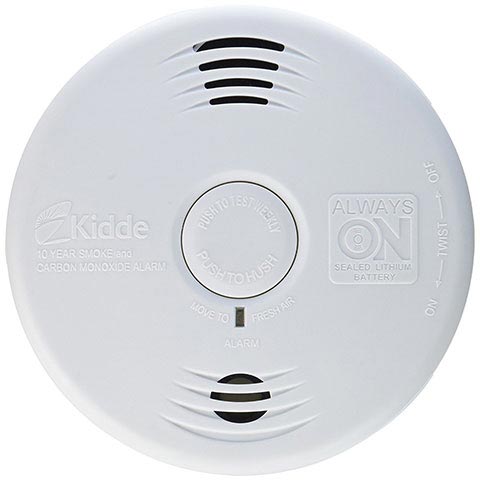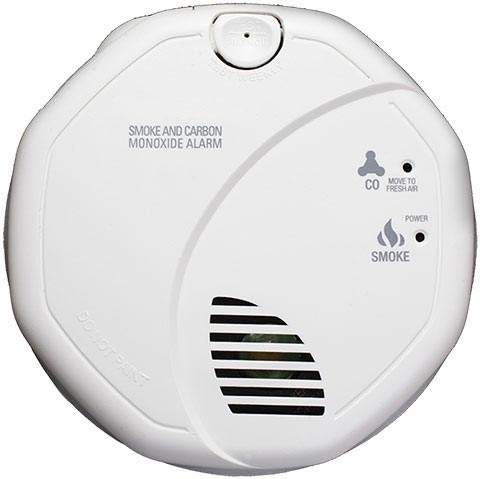Most properties in the UK use some form of combustible material to power their boiler. Whether that be gas, oil, coal, wood or even propane these are all carbon-based fuels and as such, they will give off carbon monoxide (CO) when burnt.
This colourless, odourless, and tasteless gas is the natural by-product of many home appliances. CO is produced as the result of an incomplete combustion of fossil fuels. Think of the dying embers of a fire.
Carbon fuels are normally safe, but if it does not burn properly, it produces an excess of carbon monoxide. This is when it becomes poisonous. When it builds up and enters a human’s bloodstream, CO prevents oxygen from circulating the body.
Humans cannot detect CO. It is for this reason that it gained the moniker “the silent killer.”

How Dangerous Is Carbon Monoxide?
In the UK, carbon monoxide poisoning sends 4,000 people to the hospital, some of which lead to around 50 deaths per year.
Despite the risks, however, one survey found that those who have carbon monoxide alarms installed in their homes did not even amount to half of its respondents (46.7 percent). Interestingly, 23 percent did not even know what it was.
Symptoms of Carbon Monoxide Poisoning
A few home appliances and installations could lead to carbon monoxide poisoning, including hot water heaters, furnaces, grills, room heaters, stoves, and fireplaces.
These products use a number of combustible elements like charcoal, gasoline, kerosene, propane, and wood to produce energy or heat—a potential source of CO when not installed properly.
Since CO does not have a smell nor taste, there could already be a buildup in one’s home with the occupant’s none the wiser. It also does not help that the symptoms of CO poisoning resemble that of flu, viral infections, or food poisoning.
If you or your family feel a combination of these symptoms, make sure to seek medical care urgently:
- Dizziness, nausea, vomiting
- Headaches
- Breathlessness, chest pains
- A general feeling of tiredness
- Stomach pain
- Visual problems
- Erratic behaviour
- Loss of consciousness
A blood or breath test can determine the presence of CO in the body. However, a test may come back negative if about four hours have passed since the exposure.
Preventative Measures Against CO Poisoning
When gas appliances are not properly installed nor regularly maintained, it increases the risk of CO leakage.
A few steps you can do to prevent CO poisoning include:
1. Hiring a professional team to install and maintain gas appliances
Without the proper know-how, gas appliances can leak CO into your home or office. That is why it’s always best to hire a professional team for these installations.
These experts would know the best place to put your appliances, install proper ventilation, and regularly maintain them. They would also make sure that these installations are in compliance with government regulations.
2. Not taking certain appliances indoors
Paraffin heaters, cabinet heaters, and BBQ grills are not to be taken indoors, whether that’s inside the building or a tent. The dying embers of a BBQ grill, for example, produces large quantities of CO and would potentially poison a house’s inhabitants.
3. Recognizing signs of incomplete combustion
Although we cannot sense CO, there are still a few signs of incomplete combustion that you can watch out for:
- Yellow or orange flame instead of blue
- Increase in condensation on the inside of windows
- Pilot lights blowing out
- Appliances accumulating soot and/or yellow-brown stains
4. Installing CO detectors
This is, by far, the best step you can take to make sure your home or office is free from carbon monoxide. A carbon monoxide detector would alert you if the CO level in the room has reached dangerous levels, prompting you to evacuate.

Everything You Need To Know About Carbon Monoxide Detectors
Carbon monoxide detectors function the same way smoke alarms do. They would emit a sharp beeping sound should they detect any accumulation of carbon monoxide in the area that you placed them.
The Benefits of Carbon Monoxide Detectors
Installation of detectors benefits homes and commercial spaces in a number of ways:
- Early warning sign. The alarm would only be triggered if a certain level of CO has accumulated, without risking poisoning the occupants. Rest assured that you will hear the alarm even before you start experiencing any symptoms of carbon monoxide poisoning.
- Volume can be heard by all occupants. The beeping sound is loud enough that all residents would be able to hear, giving all of you ample time to leave. Depending on how big the area is and where the gas appliances are, it would be best to install one in every room.
- Know about dysfunctional appliances. Any appliance that produces heat would also produce CO gas. If your appliances are functioning properly, the alarm would display a healthy level of CO in the atmosphere. If you see the numbers going up, then it’s time to have your appliance checked.
- Designed to avoid false alarms. Detectors also provide stability, especially against temperature change and humidity. It would only detect carbon monoxide, and not other gases or chemicals present in the home.
- Notify you even when you’re not at home. These devices come with a central monitoring system that would send you a notification should there be any CO emergency in your home. The system would then give you a call and dispatch responders if needed.
Purchasing Carbon Monoxide Detectors
There is a myriad of detectors available in the market. The main thing you should keep in mind is making sure it complies with British Standard EN 50291, as well as the device carrying a British or European approval mark (e.g. Kitemark).
When choosing, a few things you need to consider include:
- Visual and audible alarm. Older models do not have a digital display, but this would come in handy so you can see even the presence of low-level CO. If it’s a constant thing to happen, remember that prolonged exposure is also dangerous.
- Sensor life. A device can last anywhere between five and 10 years.
- Your (or your family’s) sensitivity. Alarms, by default, would go off if the CO levels reach around 50 ppm (parts per million) consistently. Most people would not feel anything at this point, however, if you have health concerns (e.g. pregnant, respiratory problems, advanced age), you may want to lower the threshold.
- Power sources. Detectors can be battery operated, plugged into a socket, hardwired into your home’s electricity, or a combination of plug-in and battery. Choose which one would best suit your needs.
- Budget. Of course, you would also need to look at how much you are going to spend, especially if you are installing it in every room of your home.
Where To Fit Carbon Monoxide Detectors
Knowing the prime locations to fit detectors is part of the job.
Install the alarms:
- At eye level, so you can easily test and see if it’s still working
- Out of reach of children and pets
- Anywhere between one and three metres from gas appliances
- Close to bedrooms, enough to wake up the occupants
- At every level of a multi-story home
You can easily install carbon monoxide detectors. DIY installation would only take about five minutes each.
By law, landlords are required to install carbon monoxide detectors, as well as conduct annual gas safety checks and maintenance. If you live in a tenanted accommodation, make sure you have a completed gas safety check certificate. Keep in mind that CO regulations vary, depending on where you are in the UK.
Carbon monoxide poses an invisible threat. However, installing a detector would give you and your family a way to keep yourself safe and away from danger.


